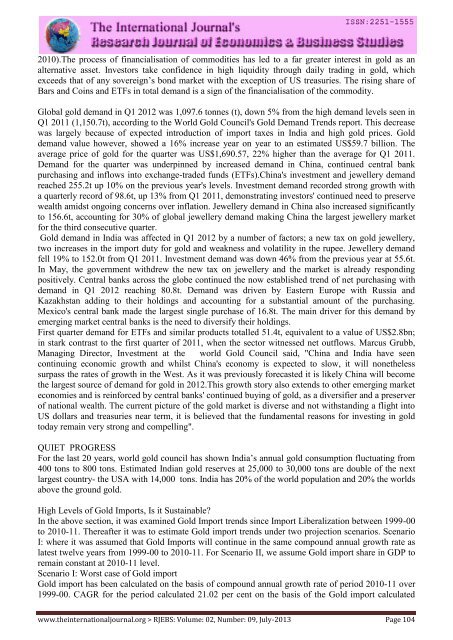Research Journal of Economics & Business Studies - RJEBS - The ...
Research Journal of Economics & Business Studies - RJEBS - The ...
Research Journal of Economics & Business Studies - RJEBS - The ...
Create successful ePaper yourself
Turn your PDF publications into a flip-book with our unique Google optimized e-Paper software.
2010).<strong>The</strong> process <strong>of</strong> financialisation <strong>of</strong> commodities has led to a far greater interest in gold as an<br />
alternative asset. Investors take confidence in high liquidity through daily trading in gold, which<br />
exceeds that <strong>of</strong> any sovereign’s bond market with the exception <strong>of</strong> US treasuries. <strong>The</strong> rising share <strong>of</strong><br />
Bars and Coins and ETFs in total demand is a sign <strong>of</strong> the financialisation <strong>of</strong> the commodity.<br />
Global gold demand in Q1 2012 was 1,097.6 tonnes (t), down 5% from the high demand levels seen in<br />
Q1 2011 (1,150.7t), according to the World Gold Council's Gold Demand Trends report. This decrease<br />
was largely because <strong>of</strong> expected introduction <strong>of</strong> import taxes in India and high gold prices. Gold<br />
demand value however, showed a 16% increase year on year to an estimated US$59.7 billion. <strong>The</strong><br />
average price <strong>of</strong> gold for the quarter was US$1,690.57, 22% higher than the average for Q1 2011.<br />
Demand for the quarter was underpinned by increased demand in China, continued central bank<br />
purchasing and inflows into exchange-traded funds (ETFs).China's investment and jewellery demand<br />
reached 255.2t up 10% on the previous year's levels. Investment demand recorded strong growth with<br />
a quarterly record <strong>of</strong> 98.6t, up 13% from Q1 2011, demonstrating investors' continued need to preserve<br />
wealth amidst ongoing concerns over inflation. Jewellery demand in China also increased significantly<br />
to 156.6t, accounting for 30% <strong>of</strong> global jewellery demand making China the largest jewellery market<br />
for the third consecutive quarter.<br />
Gold demand in India was affected in Q1 2012 by a number <strong>of</strong> factors; a new tax on gold jewellery,<br />
two increases in the import duty for gold and weakness and volatility in the rupee. Jewellery demand<br />
fell 19% to 152.0t from Q1 2011. Investment demand was down 46% from the previous year at 55.6t.<br />
In May, the government withdrew the new tax on jewellery and the market is already responding<br />
positively. Central banks across the globe continued the now established trend <strong>of</strong> net purchasing with<br />
demand in Q1 2012 reaching 80.8t. Demand was driven by Eastern Europe with Russia and<br />
Kazakhstan adding to their holdings and accounting for a substantial amount <strong>of</strong> the purchasing.<br />
Mexico's central bank made the largest single purchase <strong>of</strong> 16.8t. <strong>The</strong> main driver for this demand by<br />
emerging market central banks is the need to diversify their holdings.<br />
First quarter demand for ETFs and similar products totalled 51.4t, equivalent to a value <strong>of</strong> US$2.8bn;<br />
in stark contrast to the first quarter <strong>of</strong> 2011, when the sector witnessed net outflows. Marcus Grubb,<br />
Managing Director, Investment at the world Gold Council said, "China and India have seen<br />
continuing economic growth and whilst China's economy is expected to slow, it will nonetheless<br />
surpass the rates <strong>of</strong> growth in the West. As it was previously forecasted it is likely China will become<br />
the largest source <strong>of</strong> demand for gold in 2012.This growth story also extends to other emerging market<br />
economies and is reinforced by central banks' continued buying <strong>of</strong> gold, as a diversifier and a preserver<br />
<strong>of</strong> national wealth. <strong>The</strong> current picture <strong>of</strong> the gold market is diverse and not withstanding a flight into<br />
US dollars and treasuries near term, it is believed that the fundamental reasons for investing in gold<br />
today remain very strong and compelling".<br />
QUIET PROGRESS<br />
For the last 20 years, world gold council has shown India’s annual gold consumption fluctuating from<br />
400 tons to 800 tons. Estimated Indian gold reserves at 25,000 to 30,000 tons are double <strong>of</strong> the next<br />
largest country- the USA with 14,000 tons. India has 20% <strong>of</strong> the world population and 20% the worlds<br />
above the ground gold.<br />
High Levels <strong>of</strong> Gold Imports, Is it Sustainable?<br />
In the above section, it was examined Gold Import trends since Import Liberalization between 1999-00<br />
to 2010-11. <strong>The</strong>reafter it was to estimate Gold import trends under two projection scenarios. Scenario<br />
I: where it was assumed that Gold Imports will continue in the same compound annual growth rate as<br />
latest twelve years from 1999-00 to 2010-11. For Scenario II, we assume Gold import share in GDP to<br />
remain constant at 2010-11 level.<br />
Scenario I: Worst case <strong>of</strong> Gold import<br />
Gold import has been calculated on the basis <strong>of</strong> compound annual growth rate <strong>of</strong> period 2010-11 over<br />
1999-00. CAGR for the period calculated 21.02 per cent on the basis <strong>of</strong> the Gold import calculated<br />
www.theinternationaljournal.org > <strong>RJEBS</strong>: Volume: 02, Number: 09, July-2013 Page 104
















